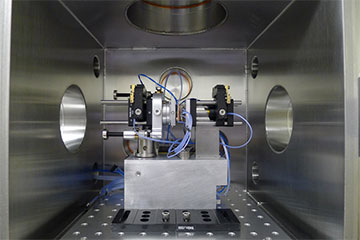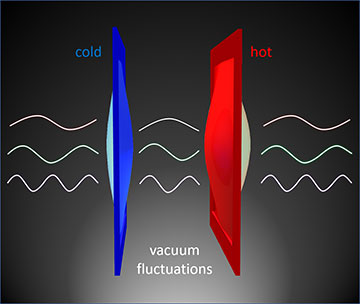
The vacuum chamber used in the experiment. [Image: Violet Carter, UC Berkeley]
The idea that heat passes through a vacuum is nothing new, given that our planet is bathed in thermal energy radiated by the sun. But scientists in the United States have now shown that heat can move through the emptiness of space in a very different way—not via radiation but a kind of quantum-mechanical conduction (Nature, doi: 10.1038/s41586-019-1800-4).
The Casimir force
This new form of heat transfer relies on the tiny attraction between two neutral objects very close to one another in a vacuum, known as the Casimir force. Predicted by Dutch physicist Hendrik Casimir in 1948, the force is due to virtual photons that the uncertainty principle tells us continually pop into and out of existence even in otherwise empty space. Because the gap between the objects becomes a kind of optical cavity that only permits certain modes of electromagnetic vibration, the radiation pressure outside those objects is very slightly greater than inside—resulting in a force that pushes them together.
According to the researchers who carried out the latest work, based at the University of California Berkeley, CA, USA, and led by Xiang Zhang, this tiny force acts like a spring connecting vibrating objects in contact with hot and cold thermal baths that are separated in space. As the hot object oscillates it transfers thermal energy, in the form of vibrations known as phonons, via the spring to the cold object. Whereas classical physics tells us that phonons require some kind of medium to pass through, the vibrations in this case propagate from one object to the other even though they are in a vacuum.
Theorists had predicted that such heat transfer should exist in nature, but calculated that it would act over scales of just a few nanometers. Trying to detect the effect across such distances would make it difficult to pick out against a background of other short-range phenomena, such as electrical interactions.
![]()
The very sensitive optics used to monitor the temperature of the vibrating membranes. [Image: Violet Carter, UC Berkeley]
Phonon coupling across a vacuum
To overcome this problem, and extend the Casimir spring over hundreds of nanometers, Zhang and colleagues carried out their measurements using a pair of very thin vibrating membranes rather than solid objects—with each membrane being fabricated from a 100-nm thick plane of silicon nitride.
The researchers put the membranes in a vacuum chamber and clamped them to substrates at different temperatures, with one a few degrees above room temperature and the other a few degrees below. By coating the substrates with gold they were able to bounce laser beams off them and then use interferometry to measure their Brownian motion, and therefore their temperatures. The group also used interferometry to align the membranes to ensure they were almost exactly parallel, a crucial requirement when investigating the Casimir force.
Zhang and co-workers made the membranes with different sizes—one being 330 μm on a side and the other 280 μm—so that they could vibrate at the same frequency even though they were at different temperatures. Exploiting this resonance, and carrying out an exacting series of measurements over the course of four years, the researchers found that when the membranes were a long way apart their temperatures as measured via their Brownian motion matched the temperatures of their respective substrates.
But they discovered that as they moved the objects closer—so that they were within 600 nm of each other—their temperatures began to diverge from those of the substrates. Once the distance got below 400 nm, the substrates’ temperatures became almost identical.

A diagram of the membranes shows heat flowing from the hotter one to the colder one, in the form of molecular vibrations known as phonons, even though the objects are in a vacuum. [Image: Zhang lab, UC Berkeley][Image: Violet Carter, UC Berkeley]
A new heat-transfer mechanism?
The researchers say that the results provide unambiguous proof of phonon transport via quantum fluctuations—having been able to rule out other possible explanations for the temperature changes, such as near-field radiation and electrostatic interactions. Their discovery, they write, “represents a previously unknown mechanism of heat transfer in addition to the conventional conduction, convection and radiation.”
In a commentary article accompanying the research, Karthik Sasihithlu of the Indian Institute of Technology Bombay in Mumbai agrees that the work “provides conclusive evidence that the Casimir force can induce heat transfer.” And he reckons it could have practical applications, for example potentially allowing heat to be dissipated from a hard disk—given that the distance between disk and writing head is just a few nanometers. “Achieving this would be a challenge for the future,” he says.
